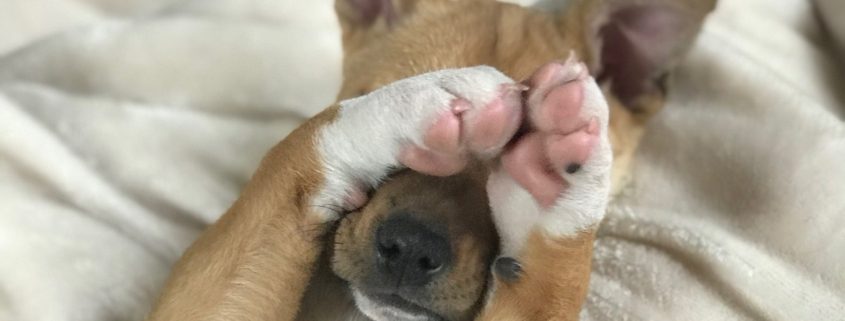Ask Crystal: Trouble-Shooting Potty Pad Use
Welcome to “Ask Crystal,” where you can ask your pet behavior questions! You can submit your question for Crystal at the bottom of the page!

I had my Chihuahua spayed at 7 months old. Before that she used her potty pads every time. Then she got crystals in her kidneys. The Vet gave her medicine for that and put her on dog food that would keep the crystals broke up. Ever since that she will use her potty pad at times and then other times she mainly pees on my recliner or in the floor. I cannot get her trained back on her potty pad now. What do I need to do? Thank you for any advice.
Sincerely,
Concerned Owner
Dear Concerned,
It is certainly frustrating when a dog starts having accidents when you thought you were done with that part of their life. Dogs that were previously housetrained having accidents can be caused by medical issues or behavioral reasons. Hopefully, with some investigation you can get down to the bottom of the issue.
Even though the crystals were treated, there is still a possibility that this is medically related. She is on the special diet food so that should be helping but it doesn’t mean it’s impossible for the crystals to come back. You also need to be sure that you aren’t feeding her any unapproved treats as that could be setting her back.
Other medical conditions such as UTI can cause accidents as well. The other possibility is that she is incontinent if she is having accidents while she is sleeping or relaxing. If she is laying on the recliner or somewhere on the floor and there is a wet spot when she gets up that could be the cause. Female dogs can develop incontinence relating to spay surgery. It can be temporary or something that always needs medication.
All in all, there is good reason to consider to investigate medical causes. If you haven’t already, make an appointment with her vet and let them know she is having accidents still. If the vet rules out a medical cause with a thorough examination, it is possible that there is a behavioral cause for the behavior. If it is medical, no amount of training is going to help so it is worth the time and money investigating it.
One behavior issue that does sometimes develop with a medical condition, is that a dog may develop a negative association with the pads because she felt pain when urinating on them. A dog doesn’t understand that the pain is not from the pads. They develop negative associations with things they happen to see when they feel pain.
 Treatment for a negative association is creating a positive association instead. Feed her a treat every single time she goes potty on the pad. Check with your vet about appropriate treats for her. You may consider purchasing an indoor potty that looks different from the pads so that if she does have a negative association with the pads, this will be something new without that connotation. If she won’t go on grass or turf, then maybe try a reusable potty pad rather than disposable or vice versa. If you have exclusively trained her to use the pads, she is probably going to prefer something similar that is soft. You could even try putting a small towel on the indoor potty and slowly make the towel smaller and smaller until she is just going on the indoor potty.
Treatment for a negative association is creating a positive association instead. Feed her a treat every single time she goes potty on the pad. Check with your vet about appropriate treats for her. You may consider purchasing an indoor potty that looks different from the pads so that if she does have a negative association with the pads, this will be something new without that connotation. If she won’t go on grass or turf, then maybe try a reusable potty pad rather than disposable or vice versa. If you have exclusively trained her to use the pads, she is probably going to prefer something similar that is soft. You could even try putting a small towel on the indoor potty and slowly make the towel smaller and smaller until she is just going on the indoor potty.
You don’t mention why you chose pads as her potty method but depending on your situation, you could also train her to go outside. I know a lot of people physically cannot do that so it might not be an option. It could be an acceptable alternative for her.
The other part of the equation is preventing the dog from going in inappropriate places. You have to go back to the beginning of housetraining where the dog is not allowed unsupervised time unless you know she is empty. That means some method of confinement like a crate. If you don’t like using crates use a pen or small dog proof room with a pad in it. When you are home, you have to watch her like an eagle. Keep her in the room with a human that is always watching her. You can use baby gates, training tethers or puppy pens to keep her from wandering. The goal being that if the dog is right in front of you, you won’t miss the signs she needs to go to her potty spot.
Prevent access to the furniture where she has her accidents. You can place something on top of the chair to keep her off. Some people use tin foil or something large that blocks the chair. You may need to get another recliner as the smell of the urine may continue to attract her there.
There is a possibility that she was never 100% potty trained even though she was only going on the pads. Usually in the beginning of training, we are so on top of it and really watching the dog and giving it lots of opportunities to go potty. As the dog seems to be doing well, we ease up and then the accidents start happening.
I have noticed some people don’t really understand that you train pads the exact same way you train a dog to go outside. I think people expect the dog to just be attracted to the pads on their own. While there may be some element of that, it isn’t enough to keep the dog from having accidents. They could also just think they are supposed to go on soft things which includes rugs, bathmats, furniture, etc.
Another behavioral cause can be anxiety. We don’t know exactly why they do it but the thought is that anxious dogs pee on furniture or beds because they heavily hold your scent and that scent is comforting to the dog. If there has been a change in schedule or routine, that can upset some dogs. Dogs that are fearful may have accidents when they are frightened. Never yell or reprimand a dog for previous accident. It doesn’t help and may make a dog more fearful.
If she seems to be very anxious or fearful consult a Certified Professional Behavior Consultant to evaluate her and determine the best treatment plan. Locate one here. Anxiety will need to be treated in order to improve. Untreated fear and anxiety almost always gets worse with time.
Remember that behavior takes time to change. If you determine this is not medically indicated; you will need to start over with the housetraining. The good news is that all of the good previous experiences she has had are there. You just need to outweigh the few bad ones she has had. Unfortunately, it takes a lot of good to outweigh the bad. With consistent supervision and reinforcing the correct behavior, we prevent the dog practicing the undesirable behavior and give them a reason to do the desired behavior. Good luck!
Until next time,
Crystal







